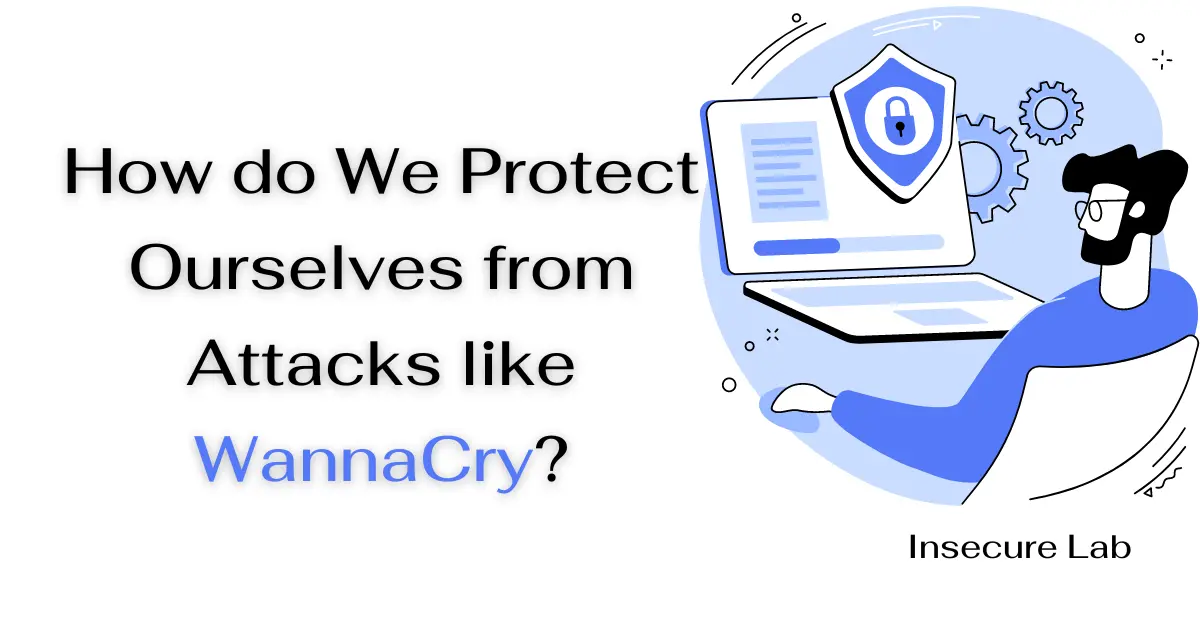Table of Contents
This comprehensive guide will explain how do we protect ourselves from attacks like WannaCry. Discover effective strategies to safeguard against WannaCry and other similar ransomware attacks.
The WannaCry Ransomware Attack
The WannaCry ransomware attack of 2017 serves as a stark reminder of the potential havoc such attacks can wreak on individuals and organizations. The attack exploited vulnerabilities in outdated Windows systems, leading to widespread disruptions and financial losses. To safeguard against similar attacks, it’s crucial to implement a combination of proactive measures, cybersecurity best practices, and a robust understanding of potential threats. This comprehensive guide will provide a detailed overview of how you can protect yourself from attacks like WannaCry.
How do We Protect Ourselves from Attacks like WannaCry?
To protect against attacks like WannaCry, ensure software updates, utilize strong security software, practice safe browsing habits, back up your data regularly, and educate yourself about potential threats.
Protect Yourself from Attacks like WannaCry
Here are some key measures and best practices to protect yourself from attacks like WannaCry:
Keep Software Updated
Regularly updating your software is one of the most fundamental steps to safeguard against cyber attacks. Attackers often exploit known vulnerabilities in outdated systems. Software updates, including operating systems, applications, and security patches, are designed to address these vulnerabilities and bolster your system’s defenses.
Utilize Antivirus and Anti-Malware Software
Installing reputable antivirus and anti-malware software is essential for proactive defense. These tools scan files, websites, and emails for malicious content and potential threats. Ensuring these tools are up to date allows them to detect and neutralize emerging threats effectively.
Enable Firewalls
Firewalls act as a protective barrier between your devices and potential threats from the internet. Both the built-in firewall of your operating system and network firewalls should be enabled. They monitor incoming and outgoing network traffic, effectively preventing unauthorized access and minimizing the risk of data breaches.
Implement Data Backup Strategies
Ransomware attacks, such as WannaCry, often hold your data hostage until a ransom is paid. Having a comprehensive data backup strategy is your best defense. Regularly back up your critical data to an external, secure location that is not directly accessible from your main network. This ensures that you can restore your data without giving in to ransom demands.
Educate and Train Users
Human error is a significant factor in cyber attacks. Educating yourself and your team about cybersecurity best practices is crucial. Regular training sessions can teach individuals how to recognize phishing attempts, avoid suspicious attachments, and make informed decisions to protect sensitive information.
Disable Unnecessary Services
Each active service or protocol on your devices and network can potentially be exploited by attackers. Disable any unnecessary services, ports, or protocols to minimize your exposure to potential vulnerabilities. This practice, known as the principle of least privilege, reduces the avenues attackers can exploit.
Segment Your Network
Network segmentation involves dividing your network into isolated segments to prevent the lateral movement of malware. Critical systems and sensitive data are isolated from less secure areas, reducing the potential impact of successful breaches.
Utilize Strong Passwords and Multi-Factor Authentication
Weak passwords are an open invitation to cybercriminals. Implement strong password policies that require a combination of letters, numbers, and symbols. Multi-factor authentication (MFA) adds an extra layer of security by requiring an additional verification step beyond the password.
Monitor Network Traffic
Regularly monitoring your network traffic helps you detect anomalies and potential security breaches. Intrusion detection and prevention systems (IDS/IPS) are valuable tools that can identify unauthorized access attempts and suspicious activities, enabling you to respond promptly.
Implement Robust Patch Management
Establish a structured process for applying security patches to software and systems. Automated patch management tools streamline this process, ensuring that critical vulnerabilities are addressed promptly.
Secure Email Practices
Phishing attacks often start with malicious emails. Exercise caution when opening attachments or clicking links, especially in emails from unknown senders. Verify the sender’s authenticity before taking any action.
Limit User Privileges
Adhering to the principle of least privilege ensures that users only have the necessary permissions to perform their tasks. By minimizing user privileges, you reduce the potential impact of compromised accounts.
Develop an Incident Response Plan
Despite your best efforts, it’s important to be prepared for potential breaches. Create a comprehensive incident response plan that outlines step-by-step procedures to follow in case of an attack. Regular testing and updates will ensure its effectiveness when needed.
Stay Informed
The landscape of cyber threats is constantly evolving. Stay informed about the latest cybersecurity news, trends, and advisories. This knowledge empowers you to adapt your security strategy and respond effectively to emerging threats.
Bottom Line
Defending against attacks like WannaCry requires a multi-faceted approach that encompasses both proactive technical measures and user awareness. By staying updated, using security tools, practicing good cyber hygiene, and remaining vigilant, you can significantly reduce the risk of falling victim to such attacks.
Remember that cybersecurity is an ongoing journey that demands continuous learning, adaptability, and a commitment to safeguarding your digital assets. With the right mindset and strategies, you can protect yourself and your organization from the ever-evolving threat landscape.

